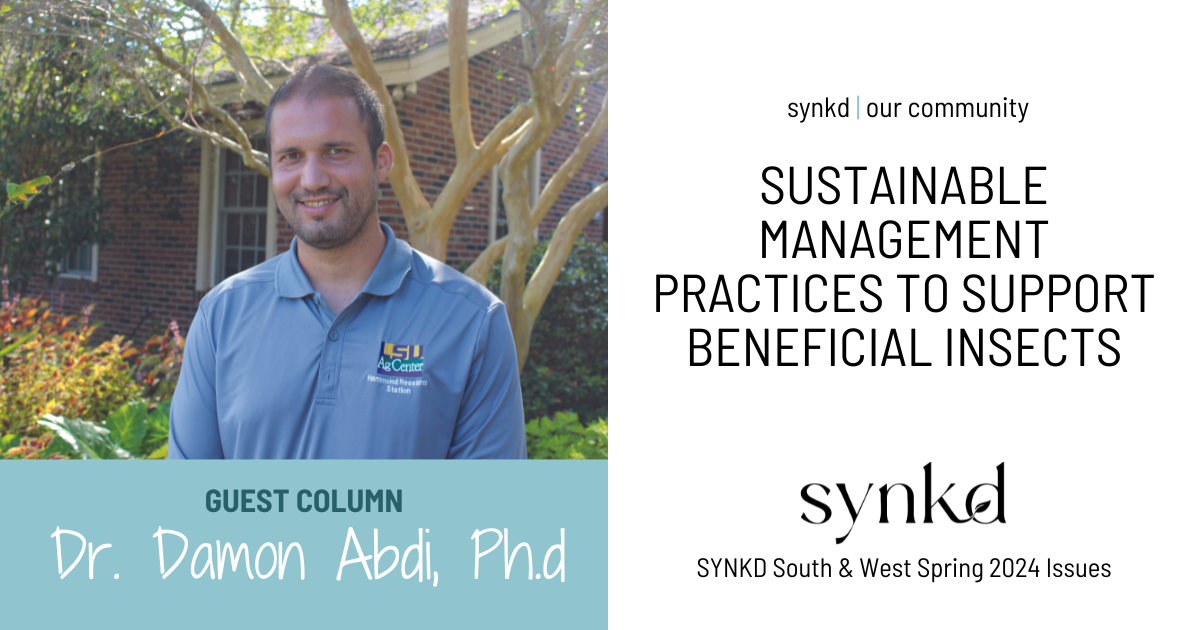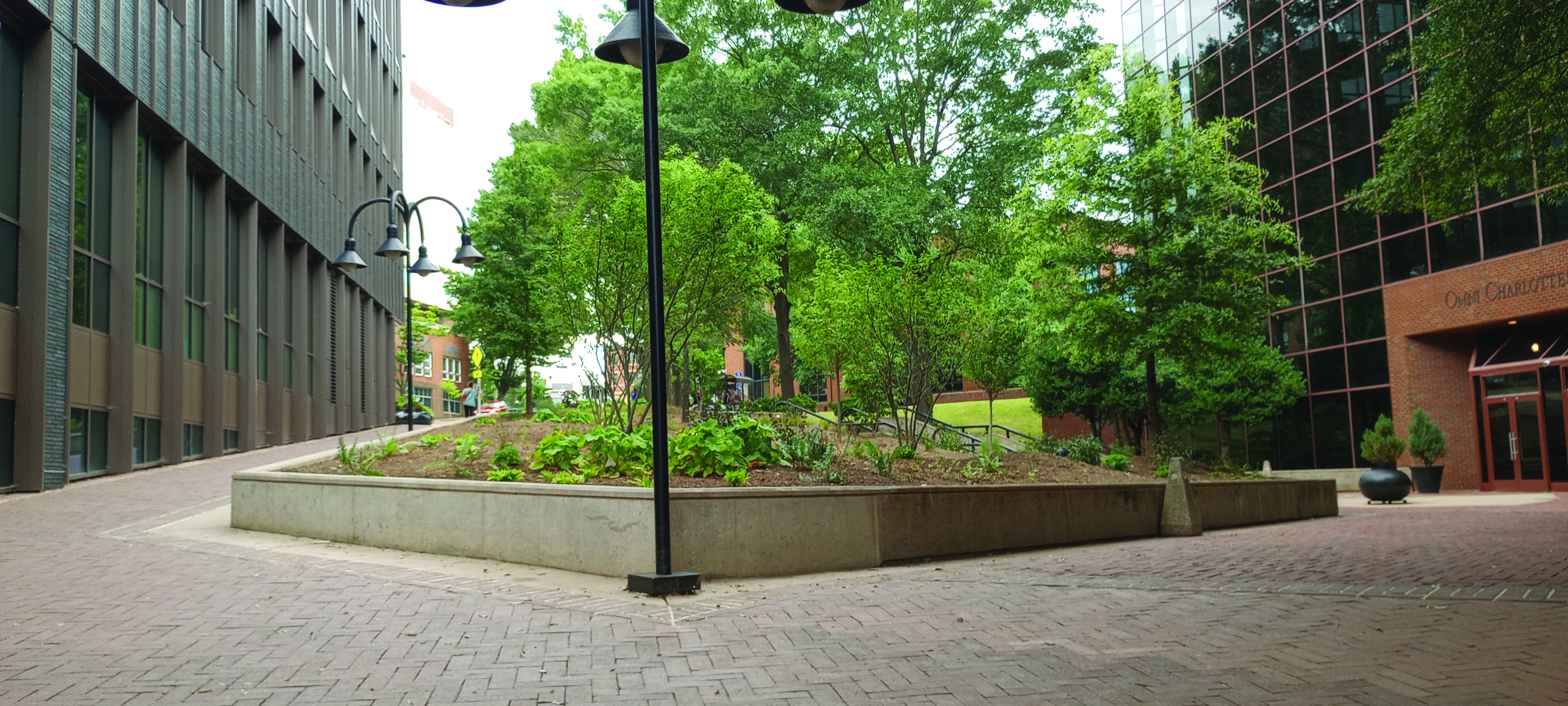
As summer’s heat approaches, we warmly welcome the longer days bound to be filled with outdoor gatherings. We fondly recollect thoughts of being at a backyard barbecue, among a crowd at a concert or by the pool; however, reality sets in to temper our expectations. We may find ourselves sweltering in that summer sun as we seek shelter from the solar rays. The canvas of concrete and steel in urban environments amplifies this heat (the urban heat island effect), burning out people and extinguishing their enjoyment of summer. In cities across the country, people find themselves in search of shade as they travel between buildings. Taking rest in a location secluded from the sun, they may long for a life where the concrete jungle yields to a more natural landscape. For those trying to catch their breath from the summer sun in the city of Charlottesville, Virginia, the redesigned landscape bed on the Historic Downtown Mall was a breath of fresh air.
This bustling pedestrian street, barricaded by bosques of trees lining the cafes, shops and small businesses, is in many ways the first impression visitors have of Charlottesville. It is in this historic outdoor hallway that many locals find themselves going for a night out on the town or to dine-in at their favorite restaurants. In such a high-activity area, the existing landscape could not keep up.
“We had an area that was in need of love—poor soil quality, tough condition,” says Landscaper Ben Schiner. Other members of the city landscaping team mentioned an abundance of weeds and lack of purpose for the space.
Taking the lead in designing the site was Theo Teichman, landscaper and project lead designer, who sought to execute a vision to support local people and plants. “This project needed to be explicitly native in response to civilian requests and to challenge ourselves to break the mold,” he says. “We didn’t want to just pick plants that everyone already knows and uses, but wanted to show the public some plants that they might not be familiar with and can find relatively easily around the area. We wanted to show that native plants can be beautiful and that urban landscapes can look different than people normally expect. It was also a great opportunity for us to learn more about new plants and to be able to trial some we haven’t used in these kinds of conditions before.”
With a clear vision to develop a native landscape in the heart of downtown Charlottesville, this team turned this dream into reality. Theo succinctly states, “We’re not restoring an ecosystem, we’re restoring a connection to place.”

Fully understanding the site was the first step. “We started by documenting existing site conditions, frequenting the bed during all seasons to remove weeds,” says Theo, pointing out the young oak trees that in future years will cast some much-needed shade on this particularly hot site. The pavement and reflection from the glass makes this site uniquely hot, despite being shaded by buildings. Challenges to consider included using natural solutions to common problems in the landscape.
“One of the big goals was managing erosion and controlling weeds and doing both of these using native plants rather than more conventional approaches,” explains Landscaper Kathleen Guevara. “Improving biodiversity was important for this unique environment,” adds Ben. “We wanted to also provide a habitat for pollinators and other insects. One of the challenges is that many plants normally used for pollinator gardens might prefer full sun or wet soils, neither of which we had.”
Plant selection was purposeful. “Since we are working with the public’s money, we want to make sure these plants are successful,” says Theo. “One of the challenges was finding plants that we would be confident would survive the many different conditions this garden might throw at it.”
The plants selected included locally acquired native species, such as wild ginger, Christmas ferns, mayapple and wild strawberry for ground cover from land owned by Parks & Recreation. “We looked to wild sites we thought were similar in terms of terrain and environmental conditions, such as clearings, rocky boulders and open forest floors, because we wanted to test these plants in the urban shade garden,” explains Theo. He expanded the scope to cast a wider net for new plants to trial. “While the Amsonia is not a Virginia native, it is native to the southeast and we found it would provide similar benefits as similar endemic plants in a Piedmont woodland while being easy to source and having wonderful and very visible fall color interest,” he says.
Indeed, this mix of southeastern selections provided many appealing features to the landscape. The site boasts a bounty of blooms. “The burgundy of the penstemons adds a spark of color and it is tall and showy,” says Landscaper Keith Cecchinelli. Kathleen adds, “The wild pinks are wonderful. They add a burst of early spring color that I hope will brighten everyone’s day when they come down here.”
Form and foliage were also heavily considered. “The goatsbeard is a great, tall element for a shade garden with lots of ecological value,” says Theo, highlighting this plant’s height.
The plant installation process was cost-efficient and effective. “For such a large bed, it would have been vastly beyond the scope of a municipal budget to fill the whole bed with plants,” says Theo. “Plants were installed in pockets to attract interest but would spread and distribute over growing seasons. Based on the reference ecosystem, plant clumps were distributed and feathered rhythmically across the bed to create a sense of depth and to naturalize the bed. Not only does this garden evoke the character of the Piedmont open woodland, but because of this naturalized character, the garden is lower maintenance and lower budget for bigger impact.”
Tying multiple seasons of landscape interest together with a long-term vision for growth, Ben explains, “All the ground covers will fill in nicely and feed the soil. The wild strawberries will get blooms and the little fruits will give bursts of color to what was previously barren soil.”
The team took on unusual considerations germane to this landscape as well. “We wanted to try out Iris cristata because we had read it has the capacity to be resistant to dog urine, which was a big issue at this garden,” says Theo. “We used it as border planting to create a buffer for the other plants.” Suffice it to say, biodiversity considerations in the urban environment may include resilient landscapes for our four-legged friends.
Taking swift action was the first step says Theo. “It was a pretty quick timeline, relatively speaking,” he explains. “We started design in February/March and began the first round of installation in April.” But the garden, much like the natural environment it seeks to emulate, is a living, breathing project. “The goal is to monitor plant performance and continue to augment with plugs, seeds, and transplants through late summer/early fall,” he adds. “We are lucky to have such a good opportunity to trial new plants and planting strategy.”

Already, the citizens of Charlottesville are appreciating this downtown addition. “There’s a group of people I see every day hanging out on the benches near the bed,” says Theo. “When we were installing and coming by to do maintenance, some of them came up to me and expressed that it’s really looking better, and they appreciate and notice the work we’re doing. This impacted me because they are the citizens experiencing this place every day, and if it makes a difference for them, then we’ve done something good for our city.”
This installation demonstrates the power of revitalizing urban landscapes and providing a service to the city, an expanding effort to make a difference no matter the scale or scope.
Just as important as cultivating a new landscape is cultivating a team of dedicated individuals. Theo supported this sentiment by highlighting the collective effort involved in this installation. “This was really a team effort,” he says. “Just like plants, people also work together and each of us brought our skills and perspectives to make a really wonderful space. Ben and Kathleen had the original idea that this neglected bed would be perfect for the native garden the citizens were asking for. Ben and I did the initial site analysis. Keith helped a lot with drafting the base plan. We all went to gather and propagate the wild plants. Kathleen and Randy [Dean] have a good eye for design and gave second opinions and feedback on layout and design.”
This installation represents a solution to evading the summer sun that many encounter in cities across the country. Creating an oasis in which citizens can seek shade and transporting them to a natural area that departs from normal city life may seem impossible. For the community in downtown Charlottesville, this project turned that into a reality. By bringing together public interest, public support and passionate people, this installation demonstrates the power of teamwork in making a difference in our communities.
Contact
Dr. Damon Abdi, Ph.D., Assistant Professor of Landscape Horticulture at LSU Ag Center
Email: dabdi@agcenter.lsu.edu
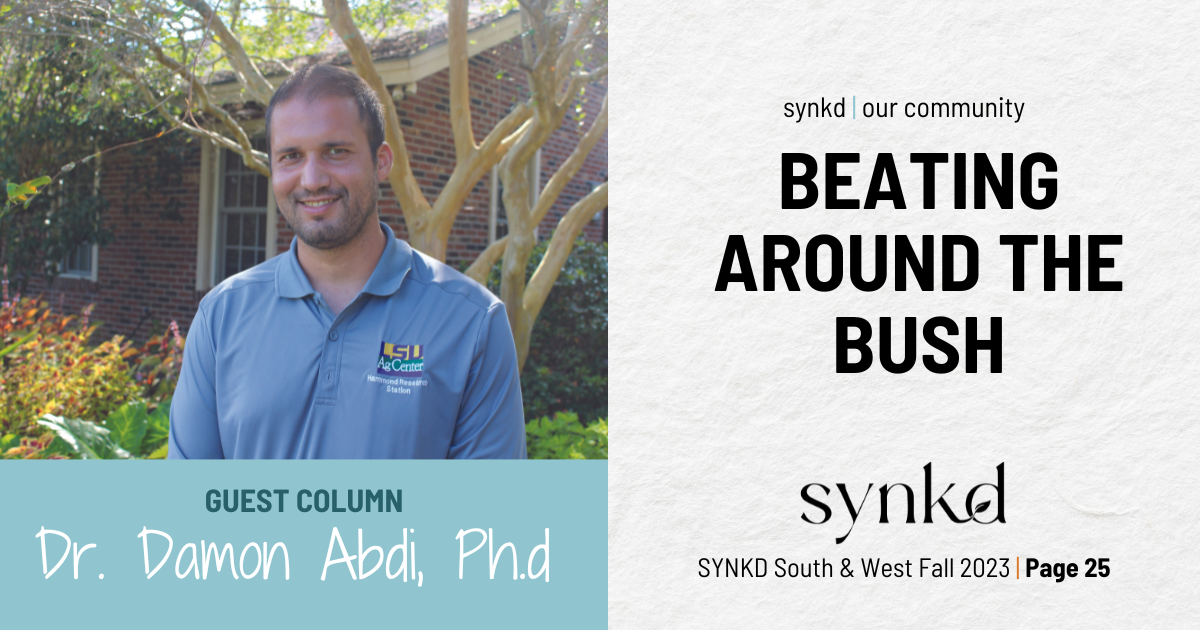
Beating Around the Bush
Damon Abdi, Ph.D., Gives Alternative Evergreen Shrubs for Borders
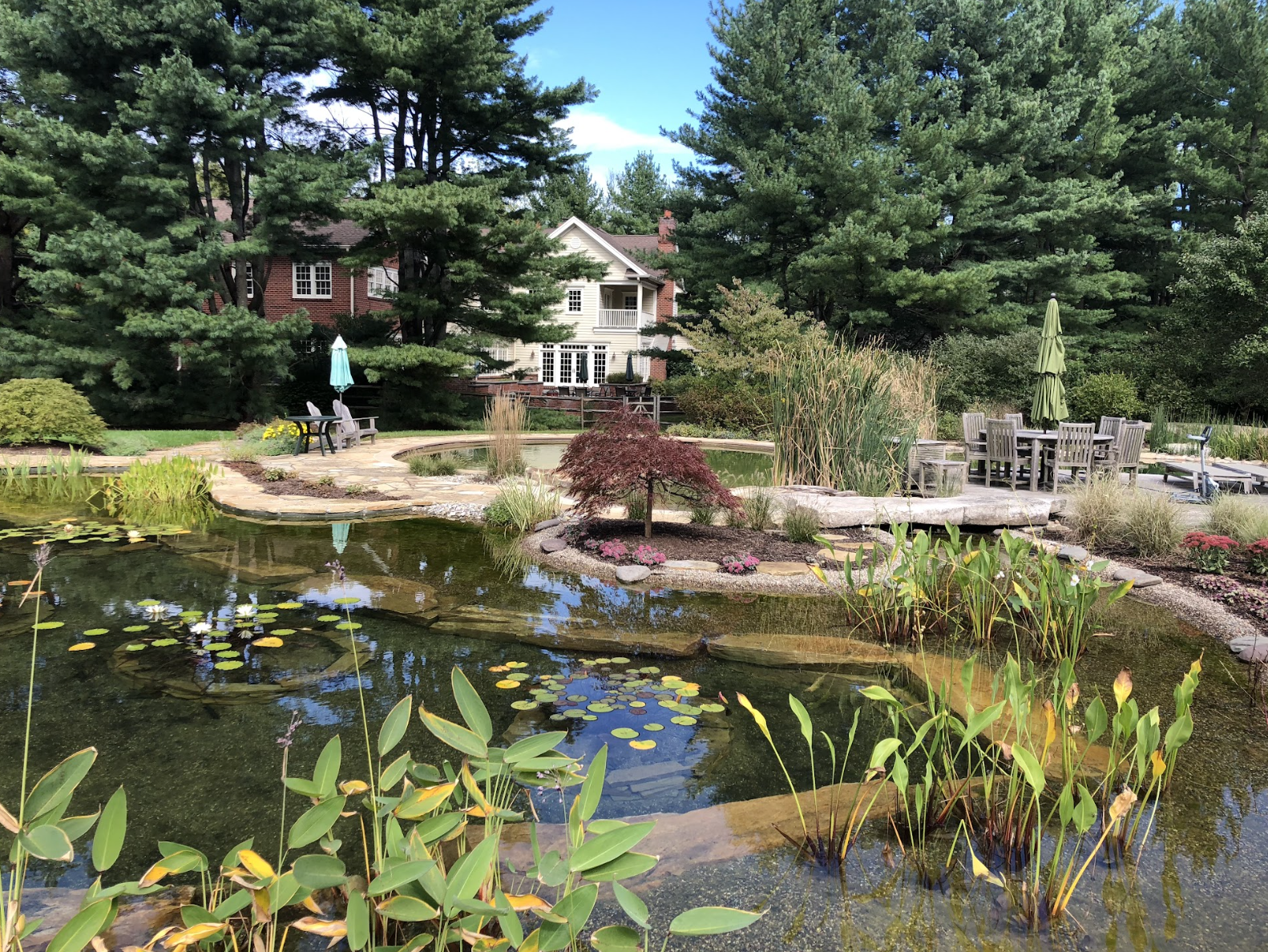
Au Naturel
PROJECT DETAILS BioSwimPonds: $100,000+ | BioPools: $75,000+ | Construction Time 6 weeks+ | Project Size: 650 square feet+
.png?width=541&height=218&name=synkd%20logo%20w%20tagline%20(2).png)



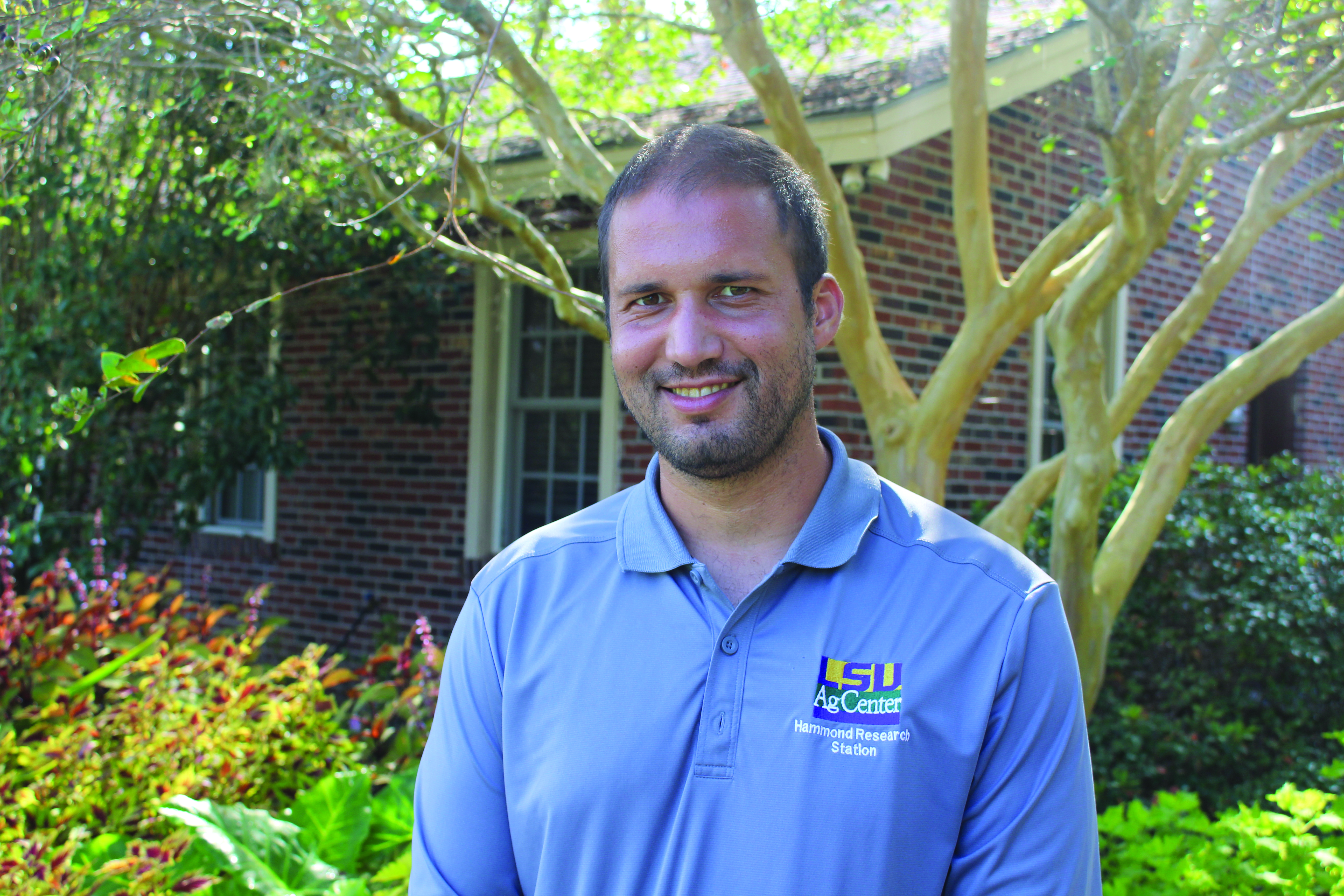 Damon Abdi
Damon Abdi
